Developing a Rating System for Building Energy Efficiency Based on In Situ Measurement in China
Abstract
:1. Introduction
2. Description of the Rating System
2.1. Evaluation Object
2.2. Evaluation Framework
2.2.1. Development of Evaluation Framework
2.2.2. Determination of Weighting and Graphic Dominant Point
- (Q/L)h—Score of indoor temperature in winter/heating energy consumption rating
- (Q/L)c—Score of indoor temperature in summer/cooling energy consumption rating
- (Q/L)i—Score of indoor illumination/lighting energy consumption rating
- (Q/L)s—Score of satisfactory level/other appliance consumption rating
- (Q/L)t—Building energy efficiency level
2.3. Data Collection and Processing
3. Rating Results and Discussion
3.1. Indoor Temperature in Winter/Heating Energy Consumption Rating
3.2. Indoor Temperature in Summer/Cooling Energy Consumption Rating
3.3. Indoor Illumination/Lighting Energy Consumption Rating
3.4. Satisfactory Level/other Energy Consumption Rating
3.5. Final Rating
4. Conclusions and Outlook
Acknowledgments
Author Contributions
Conflicts of Interest
References
- Energy Information Administration (EIA). International Energy Outlook 2014. Available online: http://www.eia.gov/outlooks/archive/ieo14/pdf/0484(2014).pdf (accessed on 25 January 2017).
- Berardi, U. A cross-country comparison of the building energy consumptions and their trends. Resour. Conserv. Recycl. 2017. [Google Scholar] [CrossRef]
- Peuportier, B.; Thiers, S.; Guiavarch, A. Eco-design of buildings using thermal simulation and life cycle assessment. J. Clean. Prod. 2013, 39, 73–78. [Google Scholar] [CrossRef]
- Li, J.; Shui, B. A comprehensive analysis of building energy efficiency policies in China: Status quo and development perspective. J. Clean. Prod. 2015, 90, 326–344. [Google Scholar] [CrossRef]
- Long, W. China: Building and Energy Overview. In Proceedings of the Tongi-PolyU Student Seminar, Sino-German College of Applied Sciences, Tongji University, Shanghai, China, May 2005.
- Ministry of Construction of the People’s Republic of China. Technical Specification for Energy Conservation Renovation of Existing Heating Residential Building (JGJ 129-2001); China Building Industry Press: Beijing, China, 2001.
- Ministry of Construction of the People’s Republic of China. Design Standard for Energy Efficiency of Residential Buildings in Hot Summer and Warm Winter Zone (JGJ 75-2003); China Building Industry Press: Beijing, China, 2003.
- Ministry of Construction of the People’s Republic of China. Design Standard for Energy Efficiency of Public Buildings (GB50189-2005); China Building Industry Press: Beijing, China, 2005.
- Ministry of Construction of the People’s Republic of China. Standard for Building Energy Performance Certification (JGJ/T288-2012); China Building Industry Press: Beijing, China, 2012.
- Ministry of Construction of the People’s Republic of China. Standard for Energy Consumption of Buildings (GB/T51161-2016); China Building Industry Press: Beijing, China, 2016.
- Wong, S.; Abe, N. Stakeholders’ Perspectives of a Building Environmental Assessment Method: The Case of CASBEE. Build. Environ. 2014, 82, 502–516. [Google Scholar] [CrossRef]
- Silvestre, J.D.; de Brito, J.; Pinheiro, M.D. From the new European Standards to an environmental, energy and economic assessment of building assemblies from cradle-to-cradle. Energy Build 2013, 64, 199–208. [Google Scholar] [CrossRef]
- Leadership in Energy & Environmental Design (LEED). Available online: http://leed.usgbc.org/leed.html (accessed on 25 January 2017).
- Comprehensive Assessment System for Built Environment Efficiency (CASBEE). Available online: http://www.ibec.or.jp/CASBEE/english/overviewE.htm (accessed on 25 January 2017).
- Ye, L.; Cheng, Z.; Wang, Q.; Lin, W.; Ren, F. Overview on Green Building Label in China. Renew. Energy 2013, 53, 220–229. [Google Scholar] [CrossRef]
- Ando, S.; Arima, T.; Bogaki, K.; Hasegawa, H.; Hoyano, A.; Ikaga, T. Architecture for a Sustainable Future; Architectural Institute of Japan: Tokyo, Japan, 2005. [Google Scholar]
- Cole, R. Building Environmental Assessment Methods: A Measure of Success; IeJC: California, CA, USA, 2013. [Google Scholar]
- Newsham, G.; Birt, B.; Arsenault, C.; Thompson, L.; Veitch, J.; Mancini, S.; Galasiu, A.; Gover, B.; Macdonald, I.; Burns, G. Do green buildings outperform conventional buildings? Indoor Environ. Energy Perform N. Am. Off. 2012, 1, 1–71. [Google Scholar]
- Gou, Z.; Lau, S.Y.; Shen, J. Indoor environmental satisfaction in two LEED offices and its implications in green interior design. Indoor Built. Environ. 2011, 21, 503–514. [Google Scholar] [CrossRef]
- Paul Warren, L.; Taylor Peter, A. A comparison of occupant comfort and satisfaction between a green building and a conventional building. Build. Environ. 2008, 43, 1858–1870. [Google Scholar]
- Li, Y.; Yang, L.; He, B.; Zhao, D. Green building in China: Needs great promotion. Sustain. Cities Soc. 2014, 11, 1–6. [Google Scholar] [CrossRef]
- Desogus, G.; Mura, S.; Ricciu, R. Comparing different approaches to in situ measurement of building components thermal resistance. Energy Build. 2011, 43, 2613–2620. [Google Scholar] [CrossRef]
- Buratti, C.; Moretti, E.; Belloni, E.; Cotana, F. Unsteady simulation of energy performance and thermal comfort in non-residential buildings. Build. Environ. 2013, 59, 482–491. [Google Scholar] [CrossRef]
- Asdrubali, F.; Buratti, C.; Cotana, F.; Baldinelli, G.; Goretti, M.; Moretti, E.; Baldassarri, C.; Belloni, E.; Bianchi, F.; Rotili, A.; et al. Domenico Palladino and Daniele Bevilacqua. Evaluation of Green Buildings’ Overall Performance through in Situ Monitoring and Simulations. Energies 2013, 6, 6525–6547. [Google Scholar] [CrossRef]
- Bisegna, F.; Mattoni, B.; Gori, P.; Asdrubali, F.; Guattari, C.; Evangelisti, L.; Sambuco, S.; Bianchi, F. Influence of Insulating Materials on Green Building Rating System Results. Energies 2016, 9, 712. [Google Scholar] [CrossRef]
- Scheuer, C.; Keoleian, G.A.; Reppe, P. Life cycle energy and environmental performance of a new university building: Modeling challenges and design implications. Energy Build. 2003, 35, 1049–1064. [Google Scholar] [CrossRef]
- Ortiz, O.; Castells, F.; Sonnemann, G. Sustainability in the construction industry: A review of recent developments based on LCA. Constr. Build. Mater. 2009, 23, 28–39. [Google Scholar] [CrossRef]
- Alyami, S.H.; Rezgui, Y. Sustainable building assessment tool development approach. Sustain. Cities Soc. 2012, 5, 52–62. [Google Scholar] [CrossRef]
- Chen, H. The Status Quo and Countermeasures of Office Building Energy Utilization in Central Government Organs in Early Twenty-First Century. Ph.D. Thesis, School of Architecture, Tsinghua University, Beijing, China, 1 September 2008. [Google Scholar]
- Ministry of Housing and Urban Rural Development & State Administration of Quality Supervision, Inspection and Quarantine. Civil Building Design Standards; China Building Industry Press: Beijing, China, 2016.
- Building Energy Saving Research Center of Tsinghua University. China Building Energy Saving Annual Development Report; China Building Industry Press: Beijing, China, 2007. [Google Scholar]
- Qin, Y.G. Green building planning and design guidelines and evaluation system. China Sci. Technol. Achiev. 2007, 11, 53–54. [Google Scholar]

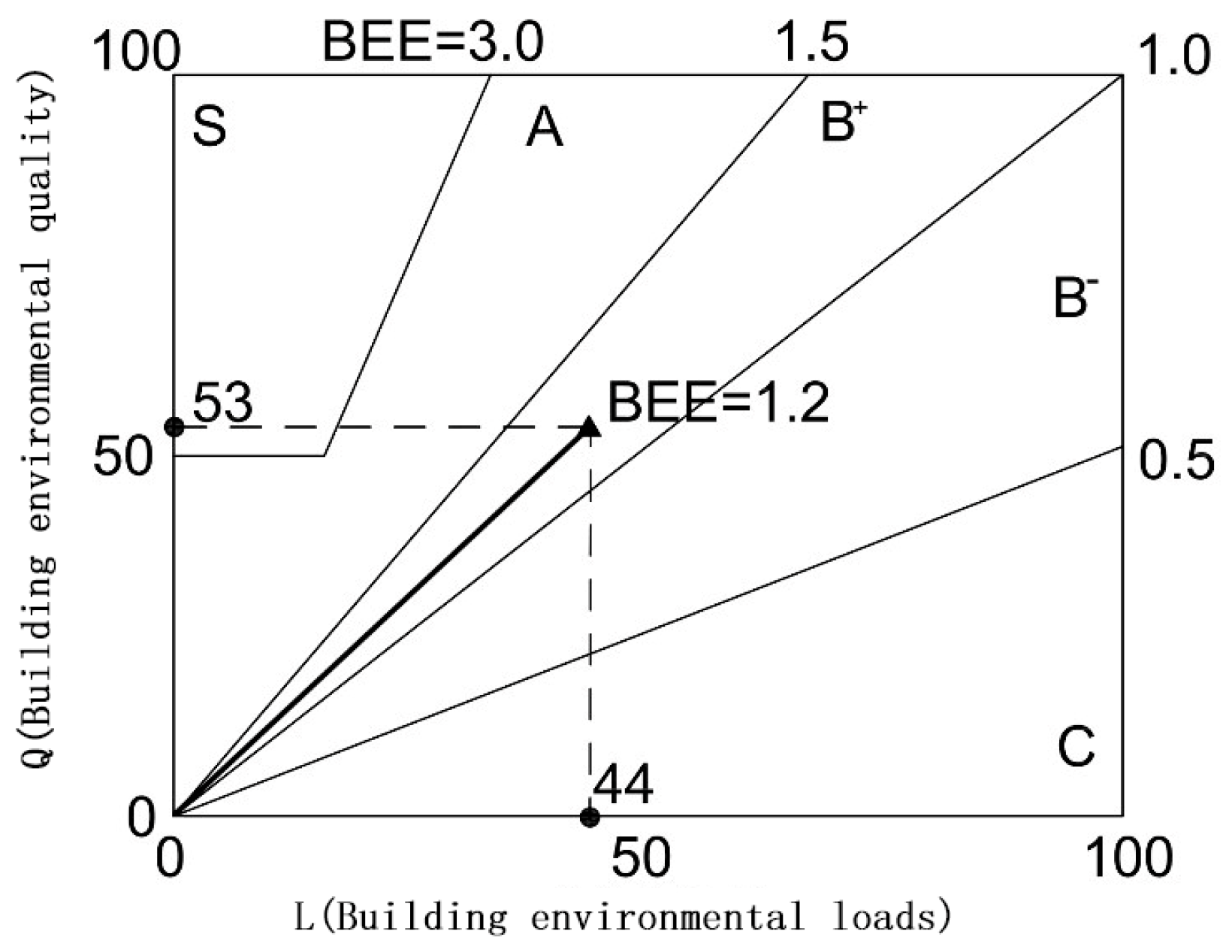
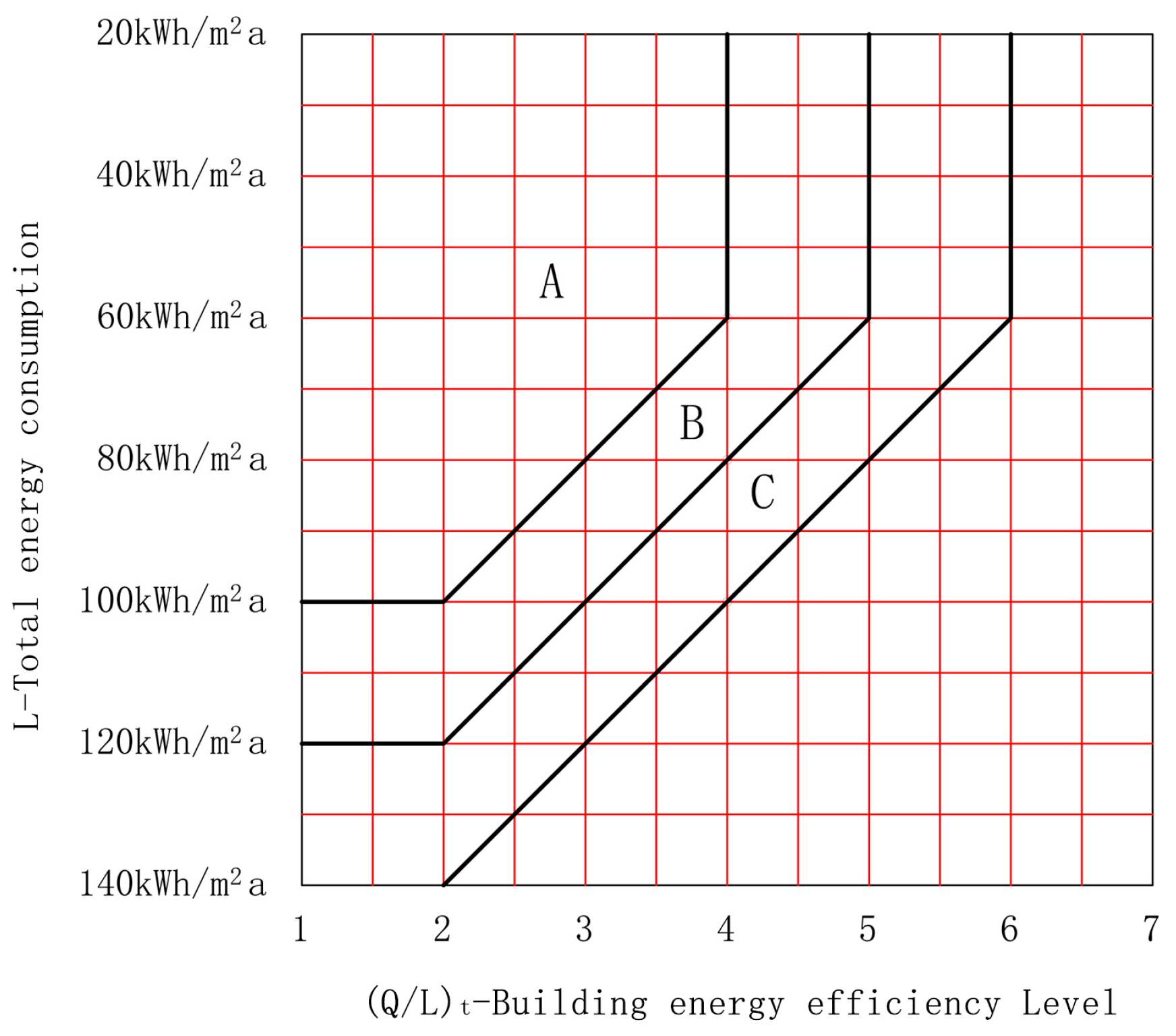
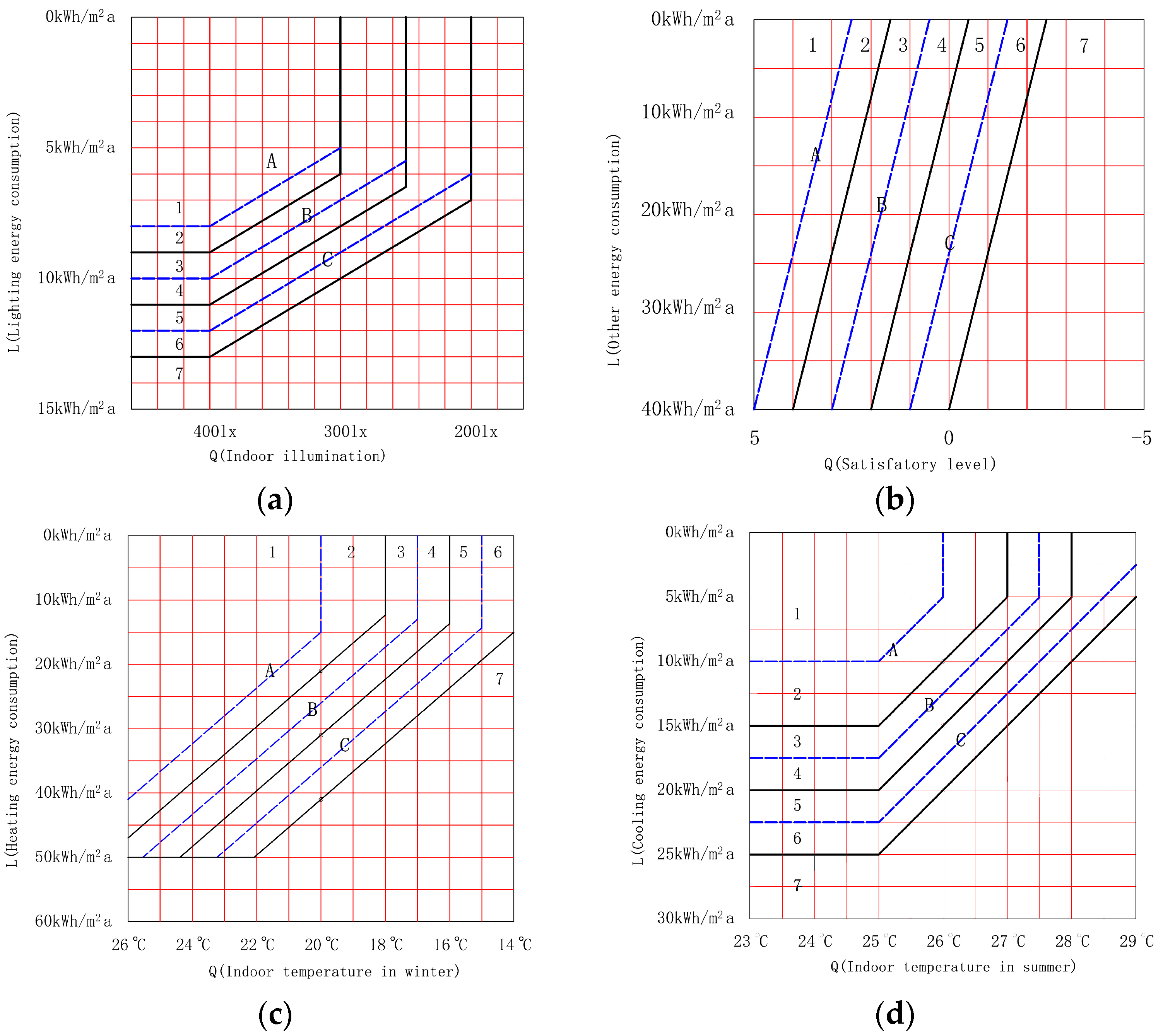
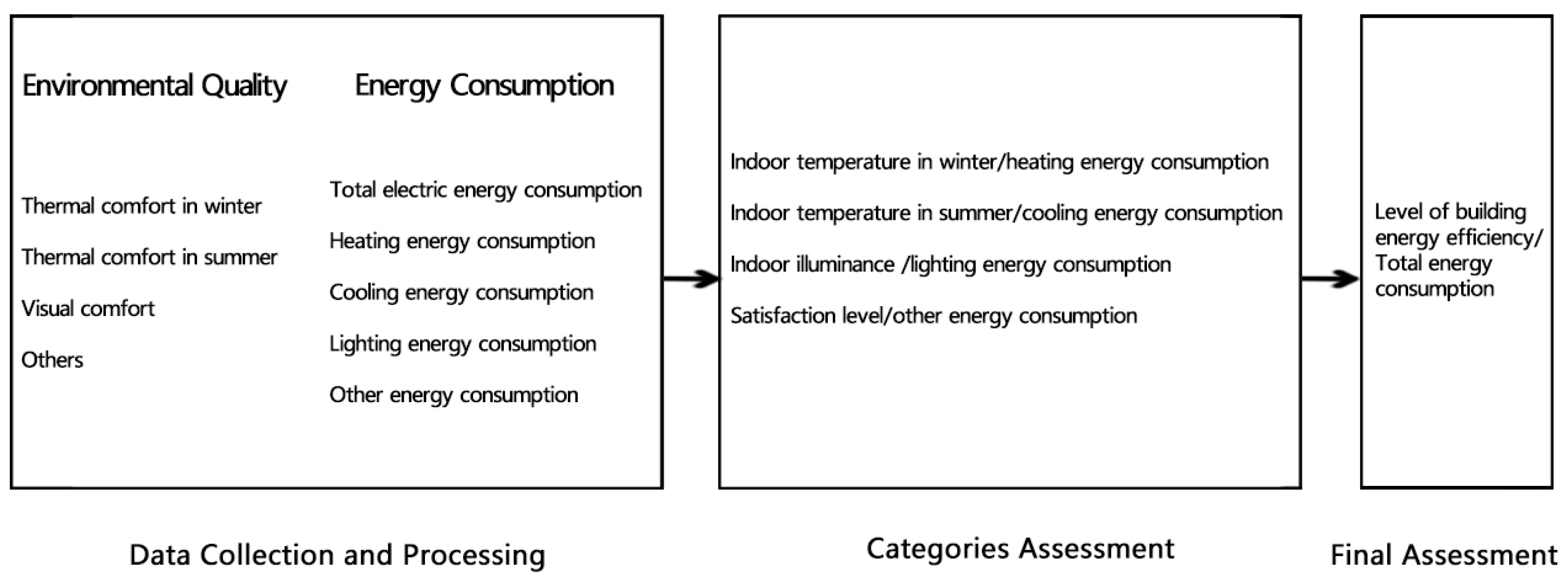
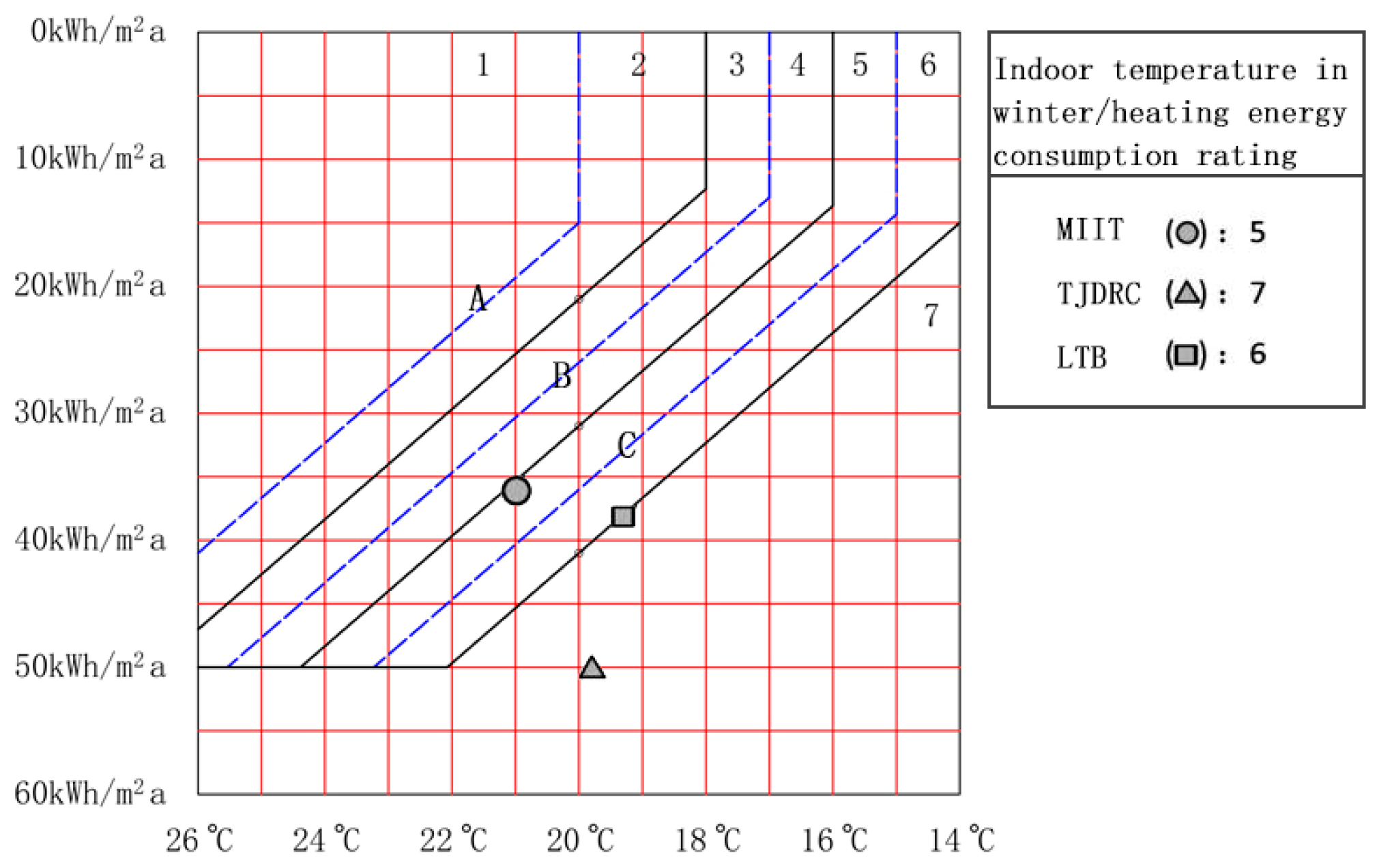
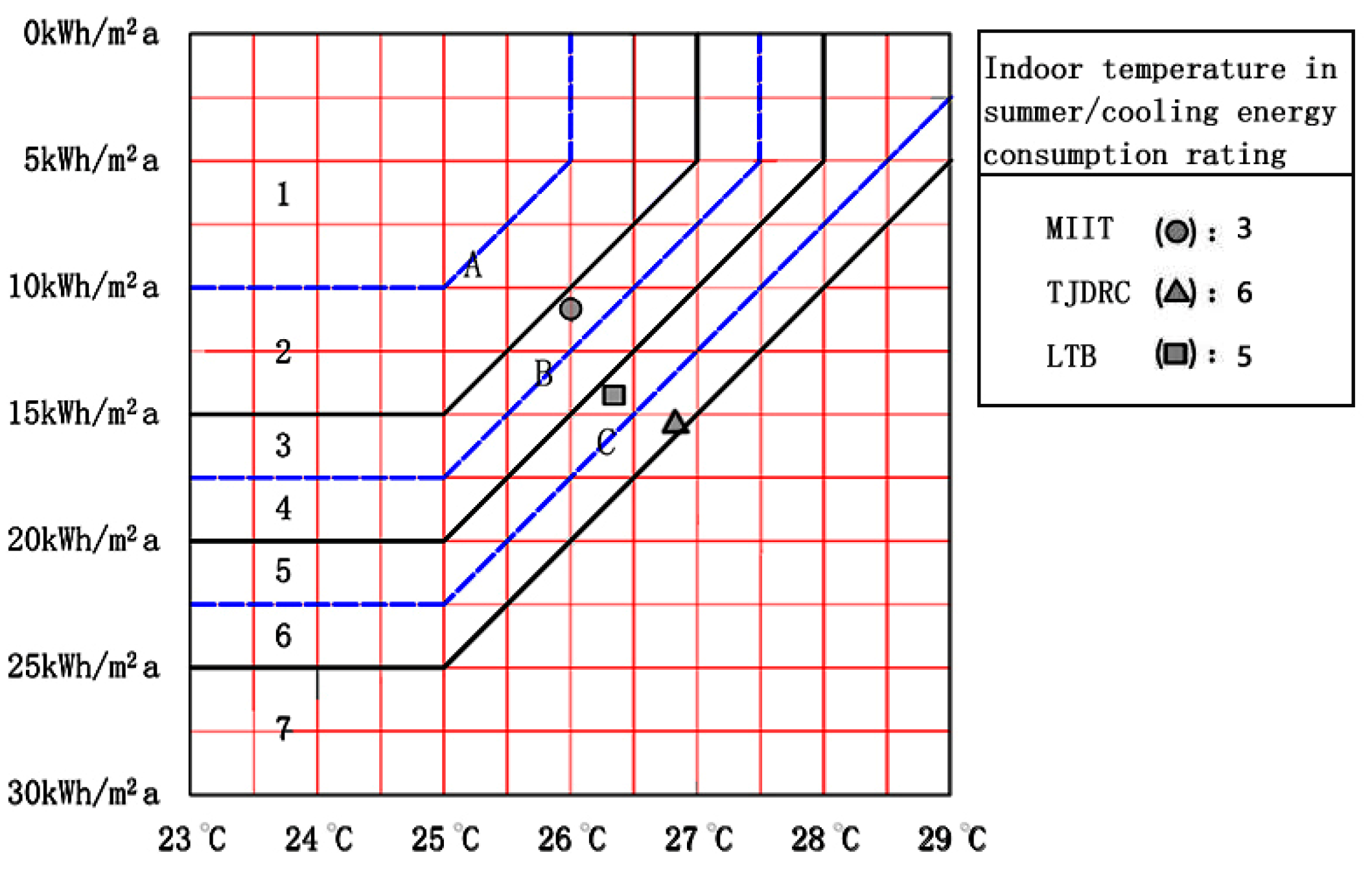
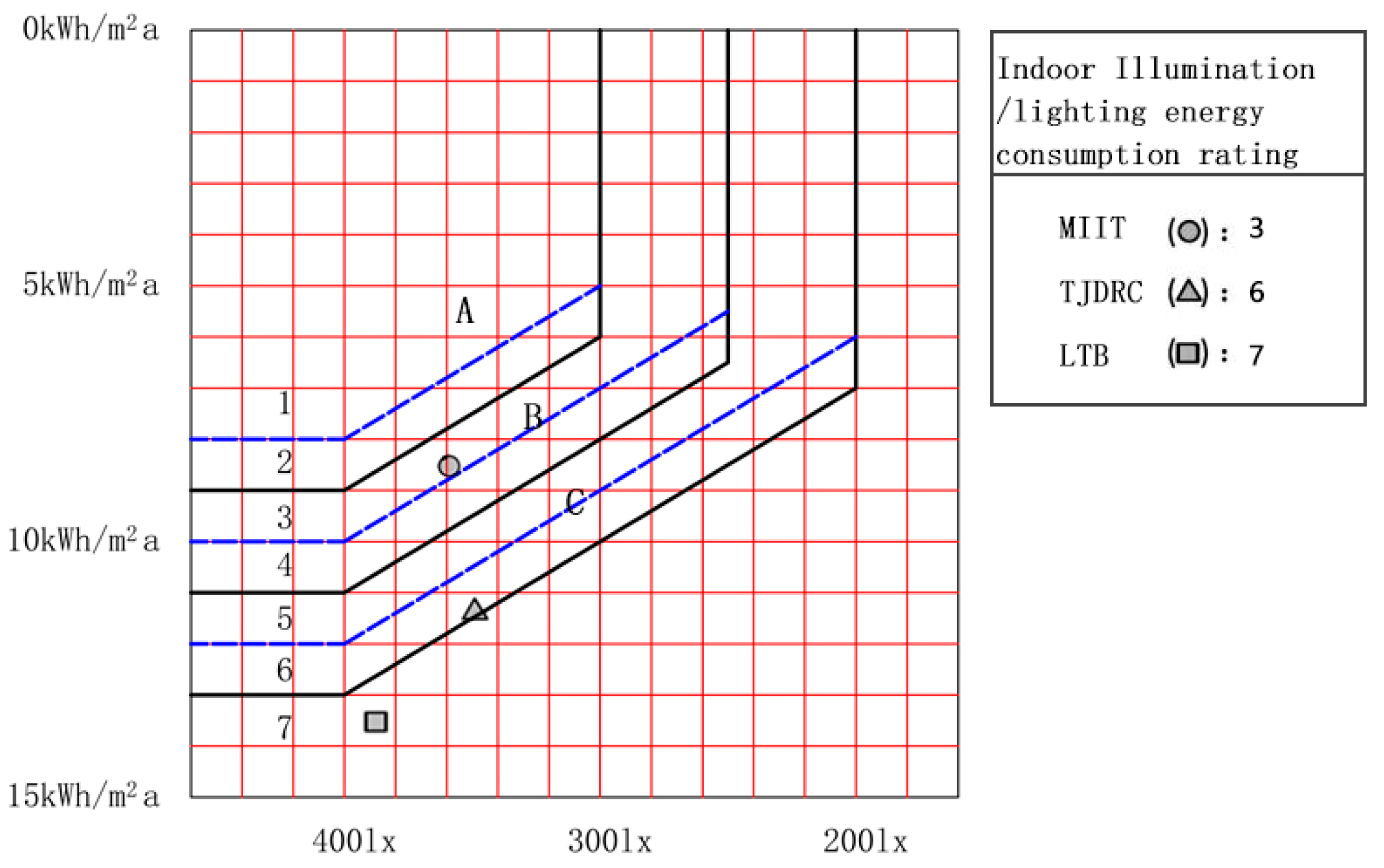
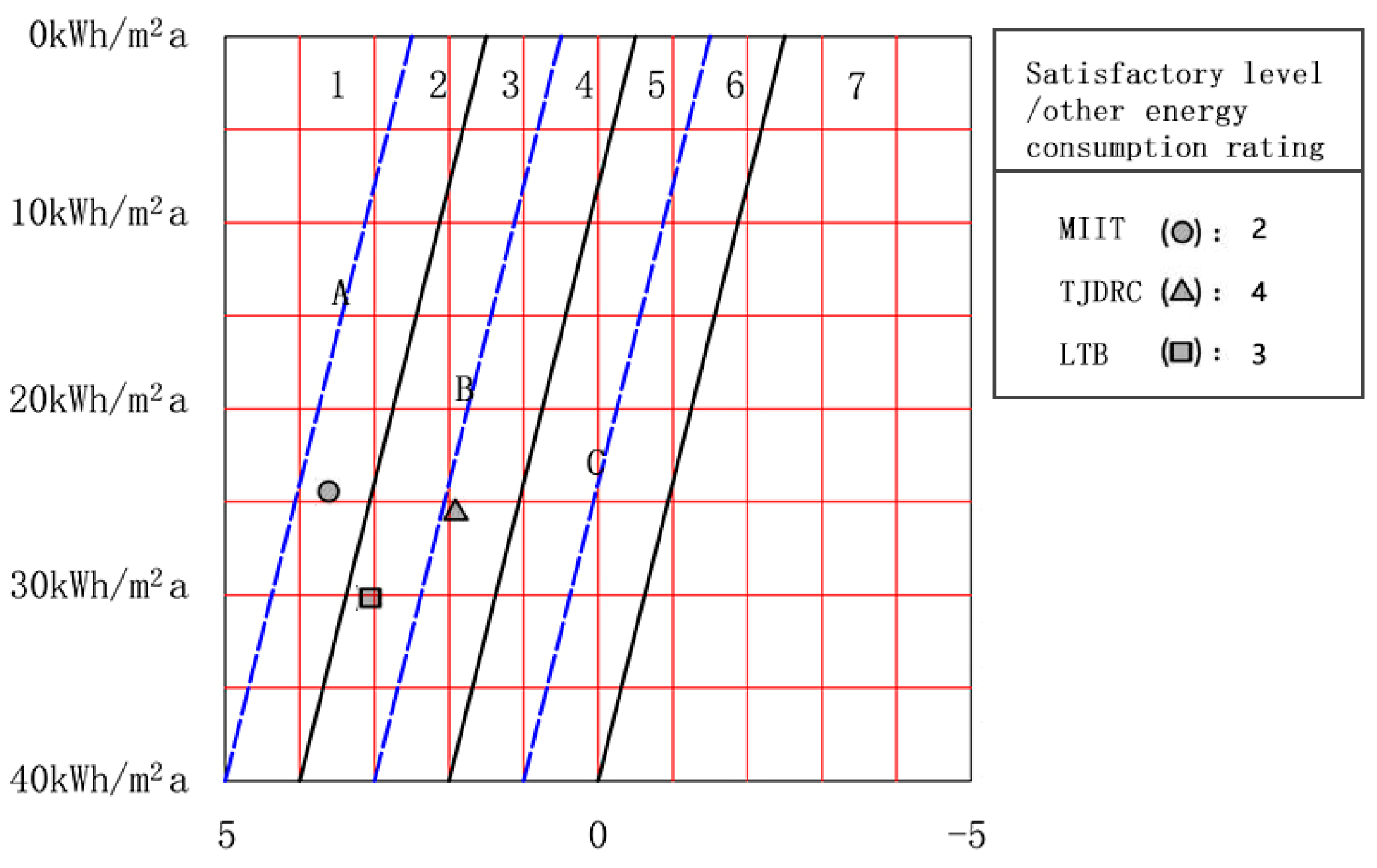
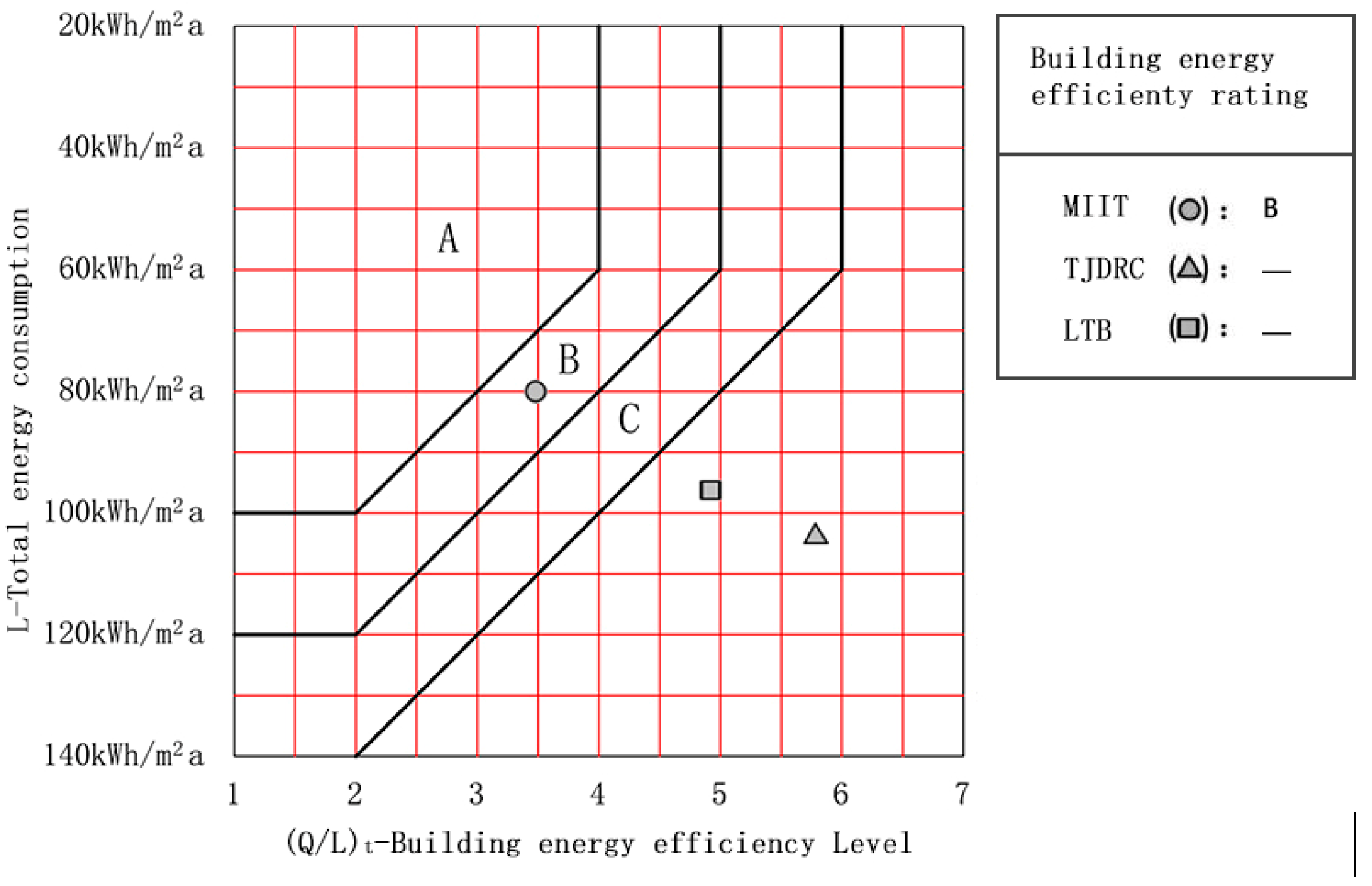
| Climate Zones | Main Climate Index | Guides for Architecture Design | |
|---|---|---|---|
| I | Severe cold zones | Average temperature in January ≤−10 °C; Average temperature in July ≤25 °C | The building must meet the requirements of heat preservation in winter, anti-freezing and other requirements. |
| II | Cold zones | Average temperature in January −10~0 °C; Average temperature in July 18~28 °C | The building must meet the requirements of heat preservation in winter, anti-freezing and other requirements. |
| III | Hot summer and cold winter zones | Average temperature in January 0~10 °C; Average temperature in July 25~30 °C | The building must meet anti-overheating, shading, ventilation and cooling requirements in summer. Anti-cold requirements should be taken into account in winter. |
| IV | Hot summer and warm winter zones | Average temperature in January >10 °C; Average temperature in July 25~29 °C | The building must meet anti-overheating, shading, ventilation, cooling and anti-rainwater requirements in summer. |
| V | Temperate zones | Average temperature in January 0~13 °C; Average temperature in July 18~25 °C | The building must meet ventilation and anti-rainwater requirements in summer. |
| Heating Energy Consumption (kgce/m2a) | Large-Scale Urban Central Heating | Small-Scale Urban Central Heating | District Central Heating | Household Heating | Average Value |
|---|---|---|---|---|---|
| Mandatory value | 9.8 | 10.3 | 13.8 | 11.1 | 11.25 (≈42 kWh/m2a) |
| Median value | 32 kWh/m2a | ||||
| Suggested value | 4.5 | 4.5 | 7.9 | 6.9 | 5.95 (≈22 kWh/m2a) |
| Energy Consumption (Heating Energy Consumption Excluded) (kWh/m2a) | State Institution Office Building (Class A) | State Institution Office Building (Class B) | Average Value |
|---|---|---|---|
| Mandatory value | 45 | 70 | 58 |
| Median value | 49 | ||
| Suggested value | 30 | 50 | 40 |
| Grade | Energy Consumption | ||||
|---|---|---|---|---|---|
| Total Energy Consumption (kWh/m2a) | Heating Energy Consumption (kWh/m2a) | Cooling Energy Consumption (kWh/m2a) | Lighting Energy Consumption (kWh/m2a) | Other Energy Consumption (kWh/m2a) | |
| A grade | 62 | 22 | 10 | 6 | 24 |
| B grade | 81 | 32 | 15 | 8 | 26 |
| C grade | 100 | 42 | 20 | 10 | 28 |
| Project | MIIT | TJDRC | LTB |
|---|---|---|---|
| Architectural Appearance |  |  |  |
| Typical Floor Plan |  |  |  |
| Location | Xicheng District of Beijing | Heping District of Tianjin | Nankai District of Tianjin |
| Floor Area | 62,700 m2 | 29,300 m2 | 7870 m2 |
| Building Story | 6 stories on the ground, 3 stories underground | 29 stories on the ground, 2 stories underground | 6 stories on the ground, 1 story underground |
| Completion Time | 2015 | 1997 | 2003 |
| Ventilation Type | hybrid | hybrid | hybrid |
| Type of lamps | led | incandescent, fluorescent | led, fluorescent |
| Project | Floor Area (Underground Parking Lot Area Is Not Included) (m2) | Heating | Cooling | Lighting | Other | Total Energy Consumption (kWh/m2a) | ||||
|---|---|---|---|---|---|---|---|---|---|---|
| Heating Energy Consumption (kWh/m2a) | Indoor Temperature in Winter (°C) | Cooling Energy Consumption (kWh/m2a) | Indoor Temperature in Summer (°C) | Lighting Energy Consumption (kWh/m2a) | Indoor Illumination (lx) | Satisfactory Level | Appliance and Other Consumption (kWh/m2a) | |||
| MIIT | 48,780 | 36.0 | 21.0 | 10.8 | 26.0 | 8.5 | 360 | 3.7 | 24.4 | 79.7 |
| TJDRC | 22,620 | 50.0 | 19.8 | 16.0 | 26.8 | 11.3 | 350 | 2.0 | 25.4 | 102.7 |
| LTB | 7870 | 38.0 | 19.2 | 14.0 | 26.4 | 13.5 | 390 | 3.1 | 30.5 | 96.0 |
© 2017 by the authors. Licensee MDPI, Basel, Switzerland. This article is an open access article distributed under the terms and conditions of the Creative Commons Attribution (CC BY) license ( http://creativecommons.org/licenses/by/4.0/).
Share and Cite
Zhao, L.; Zhou, Z. Developing a Rating System for Building Energy Efficiency Based on In Situ Measurement in China. Sustainability 2017, 9, 208. https://doi.org/10.3390/su9020208
Zhao L, Zhou Z. Developing a Rating System for Building Energy Efficiency Based on In Situ Measurement in China. Sustainability. 2017; 9(2):208. https://doi.org/10.3390/su9020208
Chicago/Turabian StyleZhao, Li, and Zhengnan Zhou. 2017. "Developing a Rating System for Building Energy Efficiency Based on In Situ Measurement in China" Sustainability 9, no. 2: 208. https://doi.org/10.3390/su9020208





